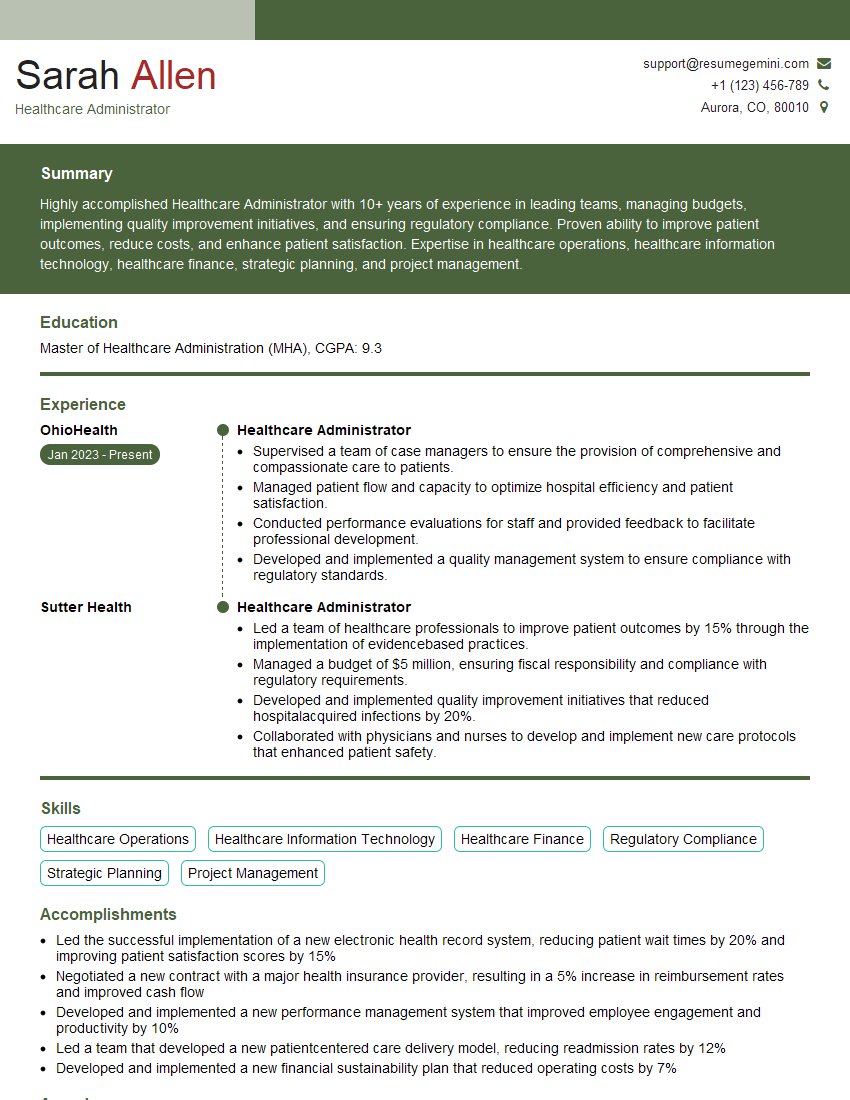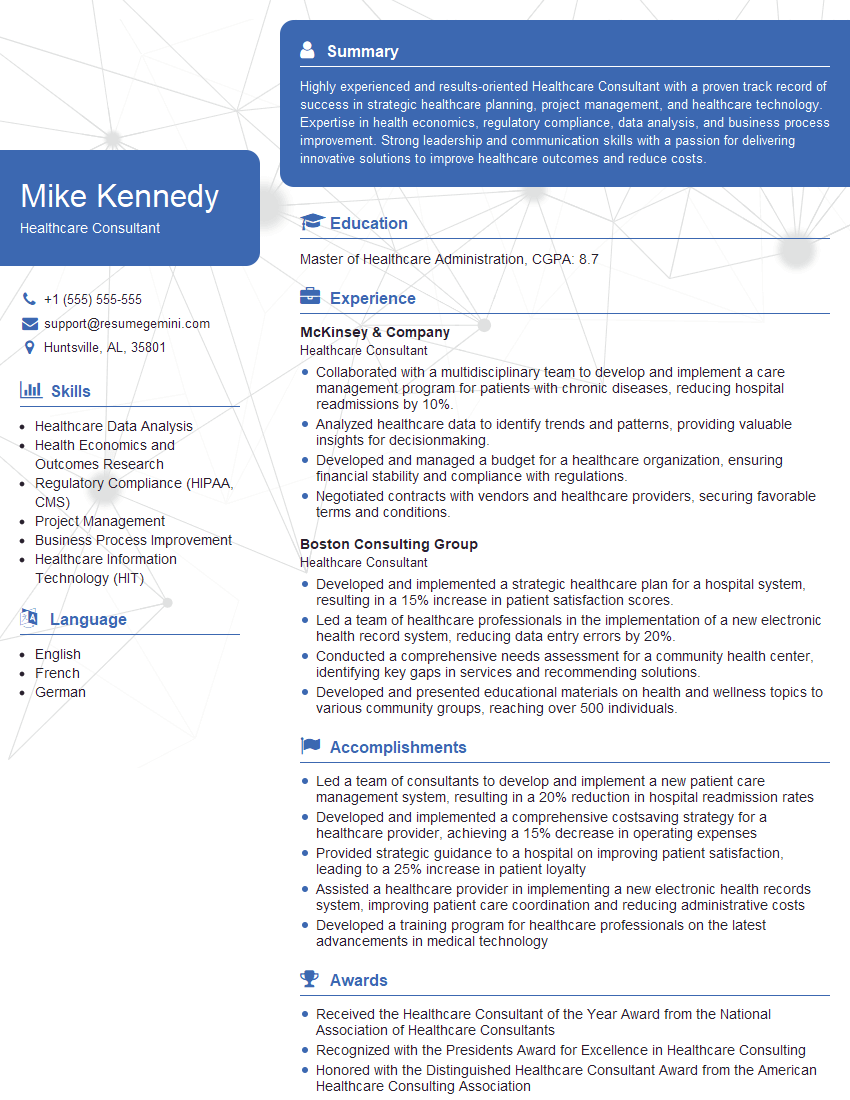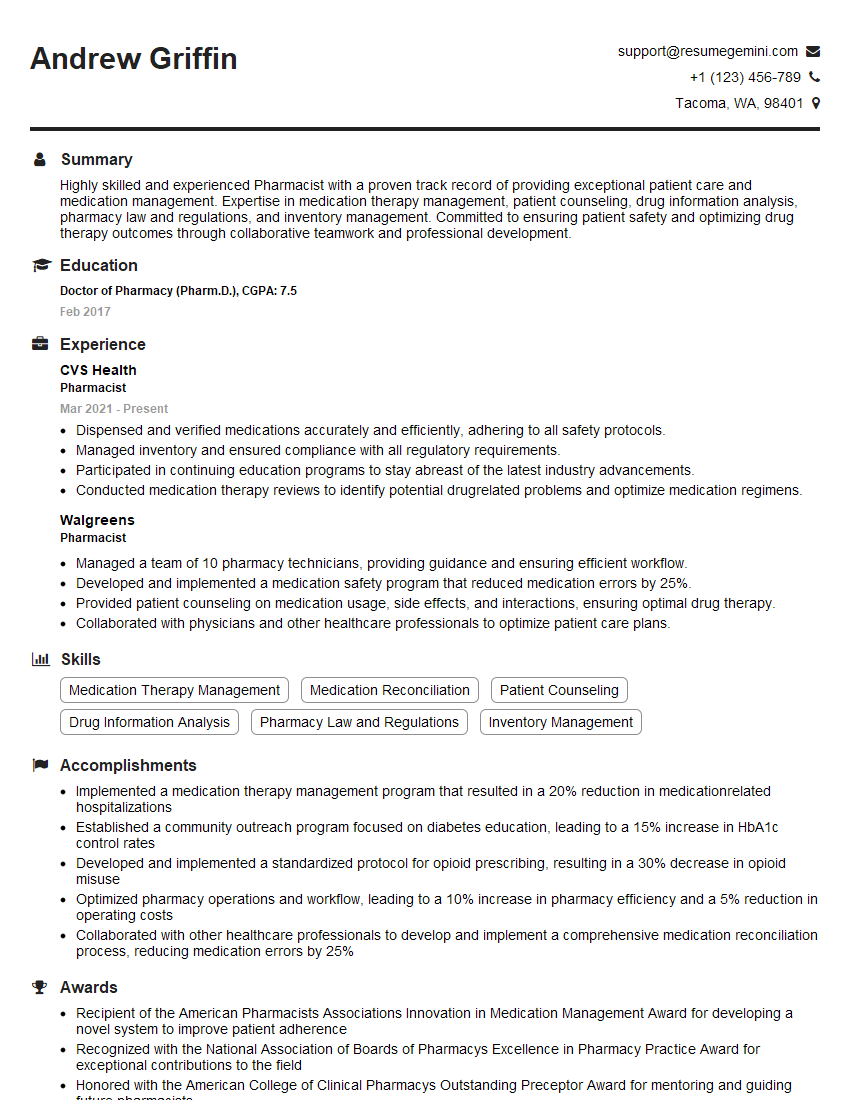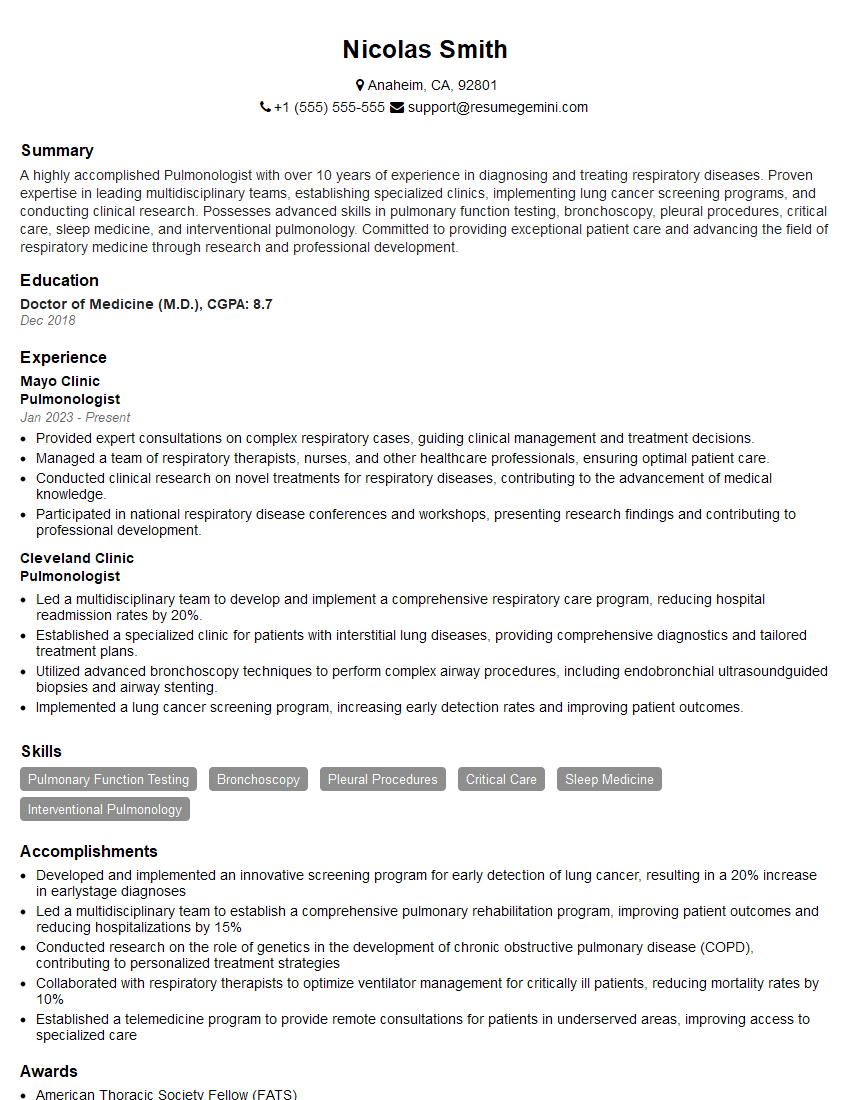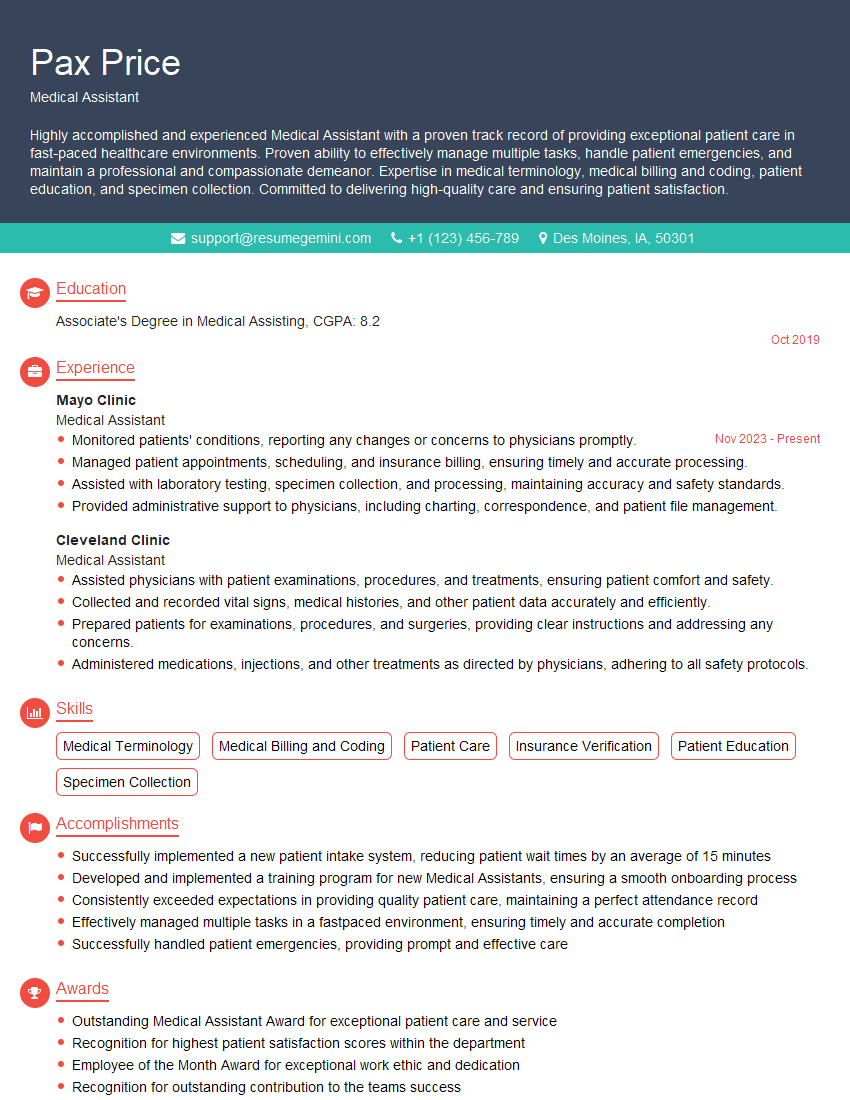Interviews are opportunities to demonstrate your expertise, and this guide is here to help you shine. Explore the essential Peak Flow Metering interview questions that employers frequently ask, paired with strategies for crafting responses that set you apart from the competition.
Questions Asked in Peak Flow Metering Interview
Q 1. Explain the principle of Peak Flow Meter operation.
A Peak Flow Meter measures the peak expiratory flow rate (PEFR), the fastest speed at which you can exhale. It works on the principle of airflow resistance. When you blow forcefully into the meter, the air pushes a lightweight indicator to a certain point. The further the indicator moves, the higher your PEFR. This measurement reflects the air that can move out of your lungs with a maximal effort and is an indicator of how well your airways are open. Think of it like blowing through a straw – the wider the straw (open airway), the easier and faster the air moves.
Q 2. Describe the different types of Peak Flow Meters available.
Peak flow meters come in various designs, but they broadly fall into two categories:
- Mini Peak Flow Meters: These are compact, lightweight, and easy to carry. They are suitable for regular monitoring at home.
- Standard Peak Flow Meters: Generally larger and may provide a wider measurement range. They often have larger displays for easier reading, especially beneficial for individuals with visual impairments.
Beyond these basic types, there are differences in features like digital displays (which provide a numerical reading), different units of measurement (liters per minute or kilometers per hour), and ergonomic design variations for optimal use.
Q 3. How do you ensure accurate Peak Flow Meter readings?
Ensuring accurate Peak Flow Meter readings requires attention to detail. Here’s a step-by-step approach:
- Proper Technique: Stand up straight and take a deep breath, filling your lungs completely. Seal your lips tightly around the mouthpiece and blow as hard and fast as you can in one continuous effort. Repeat the measurement three times and record the highest reading.
- Meter Calibration: Regularly check your peak flow meter’s calibration. Some meters have a small dial that you can adjust, while others may need professional recalibration if you suspect inaccuracies.
- Environmental Factors: Temperature and humidity can affect readings, though this influence is usually minor. Consistent environmental conditions will improve measurement reliability.
- Record Keeping: Maintain a consistent daily record of your peak flow readings. This allows you to track trends and patterns over time, providing valuable data for your doctor.
Inconsistent readings should always be discussed with a physician.
Q 4. What are the limitations of Peak Flow Meter measurements?
While Peak Flow Meters are valuable tools, they have limitations:
- Subjective Effort: The results depend on the patient’s effort. Inconsistent effort can lead to inaccurate readings. A tired or unwell patient might not be able to blow as forcefully.
- Limited Sensitivity: PEFR might not detect subtle changes in lung function. Other tests, such as spirometry, offer more detailed information.
- Not for all conditions: Peak flow meters are primarily useful for monitoring conditions like asthma and COPD. They are not suitable for all respiratory illnesses.
- Individual Variation: Personal best PEFR values vary between individuals, making comparisons difficult across patients. The most useful data comes from tracking changes in your own personal best.
Q 5. How do you interpret Peak Flow Meter results in relation to a patient’s asthma?
Peak flow monitoring helps manage asthma by tracking changes in airflow. A patient’s personal best PEFR (highest reading ever recorded) is used as a baseline. Readings are categorized as:
- Green Zone: Readings above 80% of personal best indicate good control.
- Yellow Zone: Readings between 50% and 80% of personal best suggest worsening asthma and require action (e.g., medication adjustments).
- Red Zone: Readings below 50% of personal best signal a severe asthma attack that needs immediate medical attention.
Consistent monitoring in conjunction with other clinical assessments enables proactive management and prevents severe attacks.
Q 6. Explain the importance of patient education regarding Peak Flow Meter use.
Patient education is crucial for effective Peak Flow Meter use. Patients must understand:
- Proper Technique: Accurate measurement requires consistent technique, emphasizing a forceful and sustained exhalation.
- Record Keeping: The importance of regular daily recordings to track trends and identify potential problems. Simple charts and diaries can be extremely helpful.
- Zone Interpretation: Patients need clear guidance on interpreting green, yellow, and red zones and taking appropriate actions based on their readings.
- Medication Management: Understanding how Peak Flow measurements inform medication adjustments is crucial.
- When to seek medical attention: Emphasis on contacting their physician promptly if they consistently fall into the yellow or red zones.
Effective education empowers patients to actively participate in managing their respiratory condition.
Q 7. How do you manage inconsistencies in Peak Flow Meter readings?
Inconsistencies in Peak Flow readings can stem from various factors. Addressing this requires a systematic approach:
- Review Technique: Re-educate the patient on proper technique and ensure they are following the steps correctly. Observe their technique to identify any errors.
- Check Meter Function: Verify the peak flow meter’s calibration. If there are doubts, recalibrate or replace the meter.
- Consider Other Factors: Evaluate if environmental conditions, medication changes, or underlying health issues could be contributing to the variability.
- Multiple Readings: Take multiple measurements at different times and average the highest readings to minimize variability.
- Consult Physician: If inconsistencies persist despite these steps, consult the physician. They can assess the patient’s overall condition and determine if additional tests are needed.
The goal is to identify the cause of inconsistency and implement corrective measures.
Q 8. What are the potential sources of error in Peak Flow Meter measurements?
Several factors can introduce errors into Peak Flow Meter (PFM) measurements. Accuracy depends heavily on patient technique and the meter’s condition. Inaccurate readings can lead to inappropriate treatment decisions.
- Patient Technique: Inconsistent effort, improper mouth closure around the mouthpiece, and insufficient inhalation are common causes of error. Imagine trying to blow out a candle – if your breath isn’t consistent, the flame won’t always react the same way. Similarly, a variable effort will produce variable PFM readings.
- Meter Condition: A damaged or poorly calibrated meter will give inaccurate results. A dented mouthpiece or a faulty mechanism can affect the reading significantly. Think of it like a poorly calibrated scale – if it’s not properly set, you won’t get an accurate weight.
- Environmental Factors: While less significant, temperature and humidity can have a subtle effect on readings. Extreme temperatures can affect the meter’s mechanism slightly.
- Underlying Conditions: Factors like fatigue, cough, or airway obstruction independent of the asthma itself can affect a patient’s ability to achieve their best effort, leading to lower readings.
To minimize errors, ensure proper patient training on correct technique, regular meter calibration, and understanding potential influencing factors.
Q 9. How often should a patient use a Peak Flow Meter?
The frequency of PFM use depends on the individual patient’s condition and their treatment plan. It’s crucial to follow the advice given by their physician or respiratory therapist.
Generally, patients with well-controlled asthma might use it once or twice daily, often in the morning and evening. This allows them to monitor their condition and detect any early signs of worsening. Patients experiencing more frequent or severe symptoms might be instructed to use the PFM multiple times a day or even before and after using their medication. For example, a patient might record their peak flow before using their inhaler and again after, measuring the effectiveness of their treatment.
Regular monitoring allows for early detection of asthma exacerbations, preventing hospital visits.
Q 10. What are the key indicators of worsening asthma based on Peak Flow Meter readings?
Worsening asthma is indicated by a consistent and significant drop in Peak Expiratory Flow (PEF) readings compared to the patient’s personal best (PB).
- Significant Drop from Personal Best (PB): A drop of 50% or more from a patient’s personal best is considered a significant indicator of worsening asthma and warrants immediate medical attention.
- Consistent Low Readings: Even if the reading isn’t 50% below the PB, consistently low readings over several days, even if above the 50% threshold, can also signify deteriorating asthma control.
- Trends in Readings: A gradual downward trend in PEF readings, even small decreases each day, can indicate worsening symptoms, even if the absolute values aren’t alarming. It’s not about one single measurement, but rather the overall pattern.
- Relationship to Symptoms: The decline in PEF should be considered in conjunction with the patient’s reported symptoms like increased cough, wheeze, shortness of breath, or chest tightness. A drop in PEF alongside these symptoms reinforces the concern.
It is vital to remember that a single low reading doesn’t necessarily mean a crisis. The pattern and correlation with symptoms are critical.
Q 11. How do you counsel a patient on adjusting their medication based on Peak Flow readings?
Adjusting medication based on PFM readings should always be done under the direct supervision of a healthcare professional. Patients should never self-adjust their medication without consultation. The physician or respiratory therapist will establish a personalized asthma action plan using the patient’s data and specific characteristics.
The action plan usually includes three zones: green (well-controlled), yellow (caution), and red (medical emergency). The zones are defined by ranges of PEF values. If a patient’s PEF falls into the yellow zone, they might be advised to increase the frequency of their reliever medication (like a bronchodilator). If it falls into the red zone, immediate medical attention is needed.
For example, a patient’s action plan may state: ‘If your PEF is consistently in the yellow zone (60-80% of your personal best), use your reliever inhaler every 4 hours.’ It’s essential to empower patients to understand their action plan and communicate effectively with their healthcare provider regarding any concerns or changes in their readings.
Q 12. Describe the process of calibrating a Peak Flow Meter.
Calibration ensures the PFM provides accurate readings. This is typically done using a standardized calibration device which includes a specific airflow reference. It is not performed by the patient but by healthcare personnel.
The process usually involves:
- Using a Calibration Device: A specific device, often provided by the manufacturer, is used to test the meter’s accuracy. This device generates a known airflow.
- Comparing Readings: The PFM is tested using the calibration device, and the reading obtained from the PFM is compared to the known value. Any significant difference indicates the need for adjustment or replacement of the PFM.
- Adjustment or Replacement: If the meter consistently yields inaccurate readings, a calibration procedure (usually only possible for some PFM models) might be attempted, or the meter might need to be replaced.
- Record Keeping: The calibration date and results should be recorded in the patient’s medical file.
Calibration frequency depends on usage and the meter’s type, but manufacturers often recommend yearly calibration or at least when there is suspicion of inaccuracy.
Q 13. How do you maintain a Peak Flow Meter?
Proper maintenance is crucial for PFM accuracy and longevity. This keeps the device in optimal working condition.
- Cleaning: The mouthpiece should be cleaned regularly with soap and water. Avoid harsh chemicals or abrasive materials. Dry thoroughly before use.
- Storage: Store the PFM in a safe, dry place away from extreme temperatures and direct sunlight. Avoid dropping or damaging the device.
- Regular Inspection: Periodically inspect the meter for any signs of damage or wear and tear. Replace the meter if any damage occurs to ensure accuracy and safety.
- Calibration: Follow the manufacturer’s instructions on calibration, typically performed annually or when inaccuracy is suspected.
Regular maintenance helps to ensure the PFM provides reliable readings, thus facilitating effective asthma management.
Q 14. What are the safety precautions associated with Peak Flow Meter use?
While generally safe, using a PFM requires awareness of a few precautions:
- Proper Technique: Instruct patients to follow the correct breathing technique to avoid injury. Forcing an exhale can cause dizziness or discomfort.
- Medical Supervision: PFM readings should be interpreted and used to guide treatment decisions by a healthcare professional. Never adjust medication without a doctor’s or respiratory therapist’s guidance.
- Avoidance of Misinterpretation: A single low reading does not constitute a medical emergency. Consider the overall pattern and trends, correlating them with symptoms.
- Meter Condition: Always ensure that the meter is clean, undamaged, and properly calibrated to obtain reliable measurements.
By following these precautions, patients can safely and effectively use PFMs to monitor their asthma.
Q 15. How does Peak Flow Meter data integrate with other respiratory assessment tools?
Peak flow data is a valuable piece of the respiratory puzzle, and it integrates seamlessly with other assessment tools. Think of it as one vital sign among many. For instance, it complements spirometry (FEV1, FVC measurements) by providing a quick, readily available measure of lung function at home, between clinic visits. This allows for ongoing monitoring and trend analysis, crucial in managing conditions like asthma.
It can also be combined with information from other monitoring devices, like pulse oximeters (measuring blood oxygen saturation) and even smart inhalers which track medication usage. By combining these data points, clinicians gain a more comprehensive understanding of a patient’s respiratory health. For example, a drop in peak flow accompanied by a reduced oxygen saturation level could indicate a significant worsening of the condition requiring immediate intervention. In short, the peak flow meter provides an easily accessible data point that adds significant value when viewed in conjunction with other respiratory assessment tools.
Career Expert Tips:
- Ace those interviews! Prepare effectively by reviewing the Top 50 Most Common Interview Questions on ResumeGemini.
- Navigate your job search with confidence! Explore a wide range of Career Tips on ResumeGemini. Learn about common challenges and recommendations to overcome them.
- Craft the perfect resume! Master the Art of Resume Writing with ResumeGemini’s guide. Showcase your unique qualifications and achievements effectively.
- Don’t miss out on holiday savings! Build your dream resume with ResumeGemini’s ATS optimized templates.
Q 16. Explain the difference between Peak Expiratory Flow (PEF) and FEV1.
While both Peak Expiratory Flow (PEF) and Forced Expiratory Volume in 1 second (FEV1) measure airflow, they differ significantly in their methodology and what they assess. PEF, measured using a peak flow meter, reflects the fastest airflow during a forced exhalation. It’s a quick, convenient test, ideal for self-monitoring. FEV1, on the other hand, is measured using spirometry, a more sophisticated laboratory procedure. It measures the volume of air exhaled in the first second of a forced exhalation. FEV1 assesses both the speed and volume of air expelled, providing a more detailed picture of lung function.
Imagine blowing out candles: PEF is like how hard you blow the first puff, while FEV1 is like measuring how much air you blow out in the first second of a forceful blow. FEV1 provides a more comprehensive view and often serves as a diagnostic gold standard, whereas PEF is a handy tool for monitoring changes in lung function over time.
Q 17. How do you handle a patient who is having difficulty using a Peak Flow Meter?
Difficulty using a peak flow meter can stem from various factors like physical limitations (e.g., weak hands), lack of understanding, or anxiety. My approach involves patience and education. First, I’d assess the patient’s physical capabilities. If there’s a physical limitation, I might suggest using adaptive devices or explore alternative monitoring techniques. For instance, a patient with arthritis might have difficulty with the meter itself, necessitating an alternative method of tracking their condition.
Then, I demonstrate the correct technique slowly and clearly, focusing on proper posture and breathing. I would use simple analogies, like explaining the breath as a strong and quick blast of air, comparing it to blowing out a birthday candle. I’d let them practice several times, providing encouragement and positive reinforcement. Addressing anxiety involves creating a comfortable environment, explaining the importance of the test, and answering questions thoroughly. Sometimes, a trial run with a family member present can alleviate some of the pressure. A combination of patience, clear instruction, and support goes a long way.
Q 18. What are the common challenges faced when using a Peak Flow Meter?
Common challenges include inaccurate readings due to improper technique (e.g., not blowing forcefully, insufficient exhalation time, tilting the meter), lack of patient understanding, and inconsistency in testing procedures. Environmental factors (temperature, humidity) also play a significant role. Furthermore, the meter itself might be faulty, resulting in consistently incorrect readings. Maintaining accurate patient records and ensuring proper maintenance and calibration of the equipment are also crucial aspects of minimizing challenges.
For example, a patient might struggle with the initial blow and be uncertain about how much effort to use. Proper education is essential here. Another common issue is forgetting to record measurements, especially if the patient is doing this at home independently. To overcome these challenges, clear instructions, regular follow-up, and technological assistance (using smartphone apps to log readings) are valuable. Proper training of the patient is key to effective use of the peak flow meter.
Q 19. Discuss the role of Peak Flow Meter data in asthma management plans.
Peak flow monitoring is a cornerstone of asthma management. It empowers patients to actively participate in their care. By tracking their PEF daily, patients can identify patterns, early warning signs of exacerbations, and the effectiveness of their treatment. This allows for proactive adjustments to their medication and lifestyle before symptoms worsen. This is particularly useful for patients with variable asthma.
A personalized asthma action plan is typically created, which uses PEF zones (green, yellow, red) to guide the patient’s response based on their readings. For example, a reading in the ‘yellow’ zone might indicate a need to increase medication; a reading in the ‘red’ zone usually signals a need for immediate medical attention. This proactive approach contributes to better disease control, reduced hospitalizations, and improved quality of life. It is an integral part of managing the disease effectively.
Q 20. How do you address patient concerns or questions about Peak Flow Meter results?
Addressing patient concerns about peak flow results requires a calm, reassuring, and informative approach. I would start by acknowledging their anxiety and validating their feelings. Explaining the results in a simple, non-medical way is crucial. I avoid using medical jargon and try to make it relatable.
For example, if a patient’s peak flow is in the yellow zone, I’d explain it as a signal that their airways are slightly narrower than usual, and we need to take some preventative steps. If it’s in the red zone, I’d emphasize the urgency to contact their doctor. A visual aid like a graph tracking their peak flow readings over time can be helpful in demonstrating trends and reassuring them that their data is not an isolated incident. Open communication and clear explanations build trust and empower the patient to take an active role in managing their respiratory health.
Q 21. Explain the impact of environmental factors on Peak Flow readings.
Environmental factors significantly influence peak flow readings. Cold, dry air can cause bronchoconstriction, leading to lower peak flow measurements. This is because cold air can irritate the airways and constrict the muscles surrounding them. Similarly, high levels of air pollution can worsen asthma symptoms and trigger lower readings. Conversely, warm, humid air can sometimes improve airflow.
It’s essential to consider these factors when interpreting peak flow data. If a patient experiences a drop in their peak flow, it’s crucial to assess whether it’s related to environmental factors, such as a sudden drop in temperature or a period of high pollution, or if it signals a worsening of their underlying respiratory condition. Ideally, the patient should note the weather conditions and environmental factors when recording their peak flow measurement.
Q 22. Describe the role of Peak Flow monitoring in preventing asthma exacerbations.
Peak flow monitoring plays a crucial role in preventing asthma exacerbations by enabling early detection of worsening airway obstruction. It empowers both patients and healthcare providers to proactively manage the condition. By regularly tracking peak expiratory flow (PEF) rates, individuals can identify patterns and trends, allowing for timely intervention before symptoms become severe. This early warning system allows for adjustments in medication, lifestyle, or seeking medical attention, thereby preventing hospitalizations and potentially life-threatening situations.
Imagine a car’s warning light; a consistently low peak flow reading is like that warning light, indicating a potential problem needing attention. Regular monitoring helps prevent a ‘breakdown’—a severe asthma attack.
Q 23. How do you explain the meaning of Peak Flow zones to a patient?
Explaining peak flow zones to a patient requires clear, simple language and visual aids. I’d use an analogy like a traffic light system. We have three zones: green (good), yellow (caution), and red (danger).
- Green Zone: Your lungs are working well. Keep up the good work with your medication and lifestyle habits.
- Yellow Zone: Your airways are getting tighter. It’s time to take action. This might involve increasing your medication dose (as prescribed by your doctor) or avoiding triggers.
- Red Zone: This indicates a serious problem. Your breathing is severely restricted. You need to seek immediate medical attention. This could involve using your rescue inhaler and/or contacting your doctor or going to the emergency room.
I would always emphasize that these zones are personalized to the individual patient based on their personal best peak flow reading.
Q 24. What are the different zones in a peak flow chart and their significance?
Peak flow charts typically use a three-zone system (as explained above), though some might include a fourth ‘personal best’ zone.
- Personal Best (PB): This represents the highest peak flow reading the patient has recorded over a period of time (often several weeks). It establishes the baseline for comparison.
- Green Zone: Readings in this zone (usually 80-100% of PB) indicate good lung function and airway control.
- Yellow Zone: Readings in this zone (usually 50-80% of PB) signify worsening airway obstruction. This necessitates increased vigilance and potential adjustments in treatment.
- Red Zone: Readings below 50% of PB indicate a significant reduction in lung function and signify a medical emergency. Immediate medical attention is crucial.
The significance of these zones lies in their ability to provide early warning signs of deteriorating lung function, facilitating prompt intervention and preventing serious exacerbations.
Q 25. Describe different recording methods for Peak Flow readings (e.g., paper chart, digital).
Peak flow readings can be recorded using several methods, each with its pros and cons:
- Paper Chart: This traditional method involves manually recording readings on a chart. It’s simple and doesn’t require technology, but it can be prone to errors and lacks the data management capabilities of digital methods. It’s less convenient for tracking trends over longer periods.
- Digital Peak Flow Meters: These meters electronically store and often display readings. Some models can wirelessly transmit data to smartphones or computers, facilitating easier trend analysis and data sharing with healthcare providers. This enables more efficient data management and allows for a more comprehensive view of the patient’s condition over time. Some devices even provide alerts or reminders.
- Smartphone Apps: Numerous apps are available to track peak flow readings, often integrating features for data visualization, trend analysis, and remote monitoring by healthcare professionals. This enhances patient engagement and enables timely interventions.
The choice of method often depends on patient preference, technological access, and the level of monitoring required.
Q 26. How do you determine if a Peak Flow Meter needs replacement?
A peak flow meter needs replacement when it’s no longer accurate or reliable. There are several indicators:
- Inconsistent Readings: If you get significantly different readings when you take multiple measurements in quick succession, the meter might be faulty.
- Mechanical Issues: Look for signs of damage, such as cracks in the housing or a poorly functioning pointer. If the pointer sticks or doesn’t move smoothly, it’s likely time for a replacement.
- Calibration: Peak flow meters aren’t typically calibrated in home settings. If you notice consistently low readings that don’t seem to match your symptoms, this can suggest a problem that may require professional evaluation of the meter or the need for a replacement.
- Age: While there’s no definitive lifespan, prolonged and frequent use can wear out a meter.
It’s best to replace the meter if you suspect any inaccuracy to avoid misinterpreting readings and making incorrect treatment decisions.
Q 27. Compare and contrast Peak Flow Metering with other methods of respiratory assessment.
Peak flow metering is a valuable tool, but it’s just one aspect of respiratory assessment. Let’s compare it to other methods:
- Spirometry: This provides a more comprehensive lung function assessment than peak flow, measuring various parameters like forced expiratory volume (FEV1) and forced vital capacity (FVC). It’s a more objective and detailed evaluation usually performed by a healthcare professional.
- Pulse Oximetry: This measures blood oxygen saturation, providing information about oxygen levels in the blood. While it doesn’t directly measure lung function, it is valuable in assessing the severity of respiratory distress.
- Arterial Blood Gas (ABG) analysis: This advanced test measures blood gases (oxygen and carbon dioxide) and pH levels, offering precise information on gas exchange efficiency and acid-base balance. This is typically used in hospital settings for critically ill patients.
Peak flow is a simple, portable, and patient-friendly method for monitoring daily lung function, especially useful for self-management of conditions like asthma. However, it doesn’t replace the comprehensive assessments offered by other methods, especially in diagnosing conditions or evaluating treatment effectiveness.
Q 28. What are the legal and ethical considerations related to Peak Flow Meter use and data?
Legal and ethical considerations concerning peak flow meter use and data center around patient privacy, data security, and informed consent.
- Data Privacy (HIPAA/GDPR): Peak flow data, like any health information, is subject to privacy regulations (e.g., HIPAA in the US, GDPR in Europe). This dictates how the data is stored, transmitted, and used. If digital peak flow meters or apps are used, ensuring compliance with these regulations is paramount.
- Informed Consent: Patients must be fully informed about the purpose of peak flow monitoring, how their data will be used, and who will have access to it. Their consent must be obtained before monitoring begins.
- Data Security: If using digital methods, robust security measures are essential to prevent unauthorized access or data breaches. Data encryption and secure storage are crucial.
- Data Accuracy and Integrity: Maintaining the accuracy and reliability of peak flow readings is critical. Improper use or maintenance of meters can lead to inaccurate data, impacting treatment decisions. It’s the healthcare professional’s duty to ensure the accuracy of the data collected, analyzed, and interpreted.
Adherence to these principles ensures ethical and responsible use of peak flow meters and safeguards patient rights.
Key Topics to Learn for Peak Flow Metering Interview
- Fundamentals of Respiratory Function: Understanding lung volumes, capacities, and flow rates is crucial for interpreting peak flow readings.
- Peak Flow Meter Operation and Technique: Mastering proper patient instruction and ensuring accurate measurements are key skills.
- Interpreting Peak Flow Readings: Learn to differentiate normal from abnormal readings and understand their implications for respiratory health.
- Peak Flow Monitoring in Different Patient Populations: Explore how peak flow monitoring varies for children, adults, and patients with specific conditions (e.g., asthma).
- Data Analysis and Reporting: Understand how to organize and present peak flow data effectively for clinical decision-making.
- Limitations of Peak Flow Measurement: Recognize the limitations of peak flow as a diagnostic tool and understand its role in disease management.
- Peak Flow Meter Calibration and Maintenance: Knowing how to ensure the accuracy and reliability of the device is vital.
- Relationship to other Respiratory Assessments: Understand how peak flow integrates with spirometry and other respiratory diagnostic methods.
- Troubleshooting Common Issues: Be prepared to discuss common problems encountered during peak flow measurement and how to resolve them.
- Ethical Considerations: Understand patient confidentiality and data security related to peak flow monitoring.
Next Steps
Mastering Peak Flow Metering demonstrates a strong foundation in respiratory care and can significantly enhance your career prospects in healthcare settings. A well-crafted resume is crucial for showcasing your skills and experience to potential employers. Building an ATS-friendly resume is key to getting your application noticed. To help you create a compelling resume that highlights your expertise, we recommend using ResumeGemini. ResumeGemini offers a user-friendly platform and provides examples of resumes tailored to Peak Flow Metering, ensuring your application stands out from the competition. Invest time in crafting a strong resume; it’s your first impression on a potential employer.
Explore more articles
Users Rating of Our Blogs
Share Your Experience
We value your feedback! Please rate our content and share your thoughts (optional).
What Readers Say About Our Blog
This was kind of a unique content I found around the specialized skills. Very helpful questions and good detailed answers.
Very Helpful blog, thank you Interviewgemini team.
